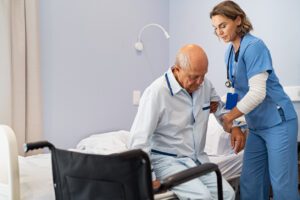Bed Sores: Causes, Warning Signs, and Prevention
 Older adults with limited mobility or those confined to bed are at serious risk of developing bed sores (also called pressure sores or pressure ulcers). Over time, as bones put continuous pressure on internal tissues, blood circulation is cut off, tissue is penetrated, and skin breaks down.
Older adults with limited mobility or those confined to bed are at serious risk of developing bed sores (also called pressure sores or pressure ulcers). Over time, as bones put continuous pressure on internal tissues, blood circulation is cut off, tissue is penetrated, and skin breaks down.
Bed sores are typically found on hips, elbows, heels, shoulder blades, and the tailbone. While they may start as a small red patch, these sores can quickly become life-threatening if not treated. That’s why healthcare professionals take them so seriously and rapidly refer the individual to a wound care specialist for evaluation.
If your loved one spends long periods lying in bed, sitting in a recliner, or using a wheelchair, they are more vulnerable to these painful wounds. Knowing the causes, warning signs, and prevention steps can make a huge difference.
These seven factors make bed sores more likely:
- Lack of movement: Lying down or sitting still for long periods of time, whether due to advanced age, serious health conditions, paralysis, coma, sedation, or injury, makes a person more vulnerable.
- Older age: Thinner, less elastic skin (common in the elderly) tears more easily.
- Poor nutrition: Lack of protein, vitamin C, zinc, and other nutrient-rich foods that support blood circulation and aid in tissue repair weakens skin.
- Being underweight: Less padding from body fat means more pressure on bones. This can happen due to medication side effects, dysphagia (difficulty swallowing), or loss of appetite.
- Smoking: Smoking narrows blood vessels and decreases circulation, preventing vulnerable tissues from receiving oxygen and nutrients.
- Incontinence: Moisture and bacteria from exposure to urine and feces make the skin break down more easily, especially around the tailbone and hips.
- Cognitive impairment: Dementia or Alzheimer’s can affect a senior’s ability to communicate, preventing them from reporting pain or discomfort.
Bed sores progress quickly if not treated. Look for these signs:
Stage 1: Red, discolored skin that may feel warm, cool, or painful appears at a bony pressure point. Blanch test: Press lightly—if it doesn’t turn white, tissue damage has begun.
Stage 2: Skin breaks open, forming a tender sore or blister.
Stage 3: A deeper wound forms, reaching fat tissue beneath the skin. Tissue decay speeds up due to decreased blood flow.
Stage 4: The sore extends down to muscle or bone. This is life-threatening and poses an extremely high infection risk.
Here are the best ways to prevent bed sores in your senior:
1. Reposition frequently: Changing positions regularly helps relieve pressure on vulnerable areas of the skin, like the tailbone, hips, heels, and elbows. Shift the weight of those in a wheelchair every 15 to 20 minutes. Reposition those who are bedbound at least every two hours. When lying down, place pillows under the calves to keep the heels elevated. Do not have someone lie directly on the hip bone when on their side. Use pillows or foam wedges to support the body and keep bony areas apart. Keep the bed incline below 30 degrees to reduce sliding.
2. Use pressure-relieving equipment: Specialized mattresses and cushions help to redistribute pressure more evenly across the body. Mattress options include static foam, gel-filled, and air mattresses. Dynamic mattresses automatically change air pressure to relieve pressure points over time. Use foam, gel, or air cushions in chairs and wheelchairs. Avoid doughnut-shaped cushions, which can concentrate pressure on surrounding tissue. Heel protectors made of foam or sheepskin can provide extra cushioning for the feet.
3. Inspect and care for your skin: Daily skin inspection is critical for catching the earliest signs of a pressure sore. Inspect all skin surfaces, especially bony or hard-to-see areas (hips, heels, and tailbone). Avoid dragging or rubbing the skin when repositioning. Wash with a mild, pH-balanced cleanser and warm (not hot) water, then pat—don’t rub—the skin dry. Change wet or soiled clothing and bedding immediately. Moisturize skin to prevent dryness – but never massage bony areas, as this can damage tissue. Use barrier creams for incontinence to create a protective layer by applying to the affected area after cleaning and drying the skin. Reapply as needed, especially after bowel movements or changes in diapers. Avoid using barrier creams on open wounds or broken skin.
Recommended barrier creams include:
– Zinc Oxide-Based Creams: Desitin Maximum Strength Diaper Rash Ointment, Boudreaux’s Butt Paste, Triple Paste Medicated Ointment
– Dimethicone-Based Creams: Aquaphor Healing Ointment, Calmoseptine Ointment, Comfort Shield Barrier Cream Cloths
– Other Barrier Creams: TENA ProSkin Barrier Cream, TriDerma Protect & Heal Non-Greasy Moisture Barrier Cream
4. Maintain good nutrition and hydration: Protein, vitamin C, zinc, calcium, and potassium are essential for healing. If a person is malnourished, nutritional supplements may be needed. Proper hydration is essential for maintaining skin health, so drink plenty of fluids.
You can spot potential bed sores early on by paying close attention to their body. Check daily for redness, swelling, or tenderness on bony areas, and for skin that feels warmer or cooler than surrounding skin. Look for any discoloration that doesn’t blanch (turn white when pressed), and for drainage, pus, or a foul odor. Take complaints of pain or discomfort seriously.
If you suspect a developing bed sore, get a medical exam scheduled for your senior immediately. Ask for a referral to a wound care specialist if needed. Don’t delay – sores can develop and worsen significantly in a matter of days!
